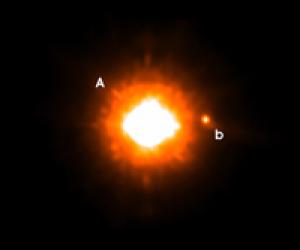The recent image of a possible planet around the star GQ Lupi has met with understandable enthusiasm in the press, but we still don’t know whether the small object just to the right of the star in the image below is a planet or a brown dwarf. The boundary between brown dwarf and planet is tricky terrain, but the European Southern Observatory fixes it at roughly 13 Jupiter masses, which is the critical mass needed to ignite deuterium. Brown dwarfs, then, are objects heavier than that.
 But the observations of Ralph Neuhäuser and colleagues do not provide a direct estimate of the smaller object’s mass. Because GQ Lupi and its companion presumably formed at the same time, then the new object is young, and traditional models for such calculations may not apply. But using them, according to a press release from the ESO, implies that the object is somewhere between 3 and 42 Jupiter masses. In other words, based on what we can determine so far, GQ Lupi b is either a planet or a brown dwarf.
But the observations of Ralph Neuhäuser and colleagues do not provide a direct estimate of the smaller object’s mass. Because GQ Lupi and its companion presumably formed at the same time, then the new object is young, and traditional models for such calculations may not apply. But using them, according to a press release from the ESO, implies that the object is somewhere between 3 and 42 Jupiter masses. In other words, based on what we can determine so far, GQ Lupi b is either a planet or a brown dwarf.
Image: The photo above shows the VLT NACO image, taken in the Ks-band, of GQ Lupi. The feeble point of light to the right of the star is the newly found cold companion. It is 250 times fainter than the star itself and it located 0.73 arcsecond west. At the distance of GQ Lupi, this corresponds to a distance of roughly 100 astronomical units. North is up and East is to the left. Credit: European Southern Observatory.
From the press release:
These early phases in brown dwarf and planet formation are essentially unknown territory for models. It is very difficult to model the early collapse of the gas clouds given the conditions around the forming parent star. One set of models, specifically tailored to model the very young objects, provide masses as low as one to two Jupiter-masses. But as Ralph Neuhäuser points out “these new models still need to be calibrated, before the mass of such companions can be determined confidently”.
The astronomers also stress that from the comparison between their VLT/NACO spectra and the theoretical models of co-author Peter Hauschildt from Hamburg University (Germany), they arrive at the conclusion that the best fit is obtained for an object having roughly 2 Jupiter radii and 2 Jupiter masses. If this result holds, GQ Lupi b would thus be the youngest and lightest exoplanet to have been imaged.
The only way to sort this out is through further observations. Meanwhile, you can read an unedited version of the Neuhäuser paper “Evidence for a co-moving sub-stellar companion of GQ Lupi” here (PDF warning). The paper has already been accepted for publication in Astronomy and Astrophysics.


Astrometric and photometric monitoring of GQ Lup and its sub-stellar companion
Authors: Ralph Neuhaeuser, Markus Mugrauer, Andreas Seifahrt, Tobias Schmidt (AIU Jena), Nikolaus Vogt (Valparaiso)
(Submitted on 15 Jan 2008)
Abstract: Neuhaeuser et al. (2005) presented direct imaging evidence for a sub-stellar companion to the young T Tauri star GQ Lup. Common proper motion was highly significant, but no orbital motion was detected. Faint luminosity, low gravity, and a late-M/early-L spectral type indicated that the companion is either a planet or a brown dwarf.
We have monitored GQ Lup and its companion in order to detect orbital and parallactic motion and variability in its brightness. We also search for closer and fainter companions. We have taken six more images with the VLT Adaptive Optics instrument NACO from May 2005 to Feb 2007, always with the same calibration binary from Hipparcos for both astrometric and photometric calibration. By adding up all the images taken so far, we search for additional companions. The position of GQ Lup A and its companion compared to a nearby non-moving background object varies as expected for parallactic motion by about one pixel (2 \pi with parallax \pi). We could not find evidence for variability of the GQ Lup companion in the K-band (standard deviation being \pm 0.08 mag), which may be due to large error bars. No additional companions are found with deep imaging.
There is now exceedingly high significance for common proper motion of GQ Lup A and its companion. In addition, we see for the first time an indication for orbital motion (about 2 to 3 mas/yr decrease in separation, but no significant change in the position angle), consistent with a near edge-on or highly eccentric orbit. We measured the parallax for GQ Lup A to be \pi = 6.4 \pm 1.9 mas (i.e. 156 \pm 50 pc) and for the GQ Lup companion to be 7.2 \pm 2.1 mas (i.e. 139 \pm 45 pc), both consistent with being in the Lupus I cloud and bound to each other.
Comments: A&A in press
Subjects: Astrophysics (astro-ph)
Cite as: arXiv:0801.2287v1 [astro-ph]
Submission history
From: Ralph Neuhaeuser [view email]
[v1] Tue, 15 Jan 2008 13:11:44 GMT (170kb)
http://arxiv.org/abs/0801.2287